Everything You Need to Know Before Getting a Cartilage Piercing
In the realm of personal style and self-expression, cartilage piercings have emerged as captivating adornments that add a touch of mystique to your overall look. In this comprehensive guide, we will delve into the intricate world of cartilage piercings, exploring their various facets, from defining the art to understanding the types, weighing the advantages and disadvantages, determining who should embrace this trend, offering essential care tips, and sharing the secrets to healing these stylish additions. Let’s dive into the world of cartilage piercings Everything You Need to Know Before Getting a Cartilage Piercing Understanding Cartilage Piercings Cartilage piercings are a […]

In the realm of personal style and self-expression, cartilage piercings have emerged as captivating adornments that add a touch of mystique to your overall look. In this comprehensive guide, we will delve into the intricate world of cartilage piercings, exploring their various facets, from defining the art to understanding the types, weighing the advantages and disadvantages, determining who should embrace this trend, offering essential care tips, and sharing the secrets to healing these stylish additions.
Let’s dive into the world of cartilage piercings

Everything You Need to Know Before Getting a Cartilage Piercing
Understanding Cartilage Piercings
Cartilage piercings are a form of body modification that involves puncturing the tough, flexible cartilage tissue found in various parts of your ear. These punctures create opportunities to showcase your style and personality, making cartilage piercings a captivating addition to your overall aesthetic. While they offer a striking visual appeal, cartilage piercings come with their unique set of pros and cons, making it essential to explore the details before making your style statement.
Cartilage piercings come with their unique set of pros and cons
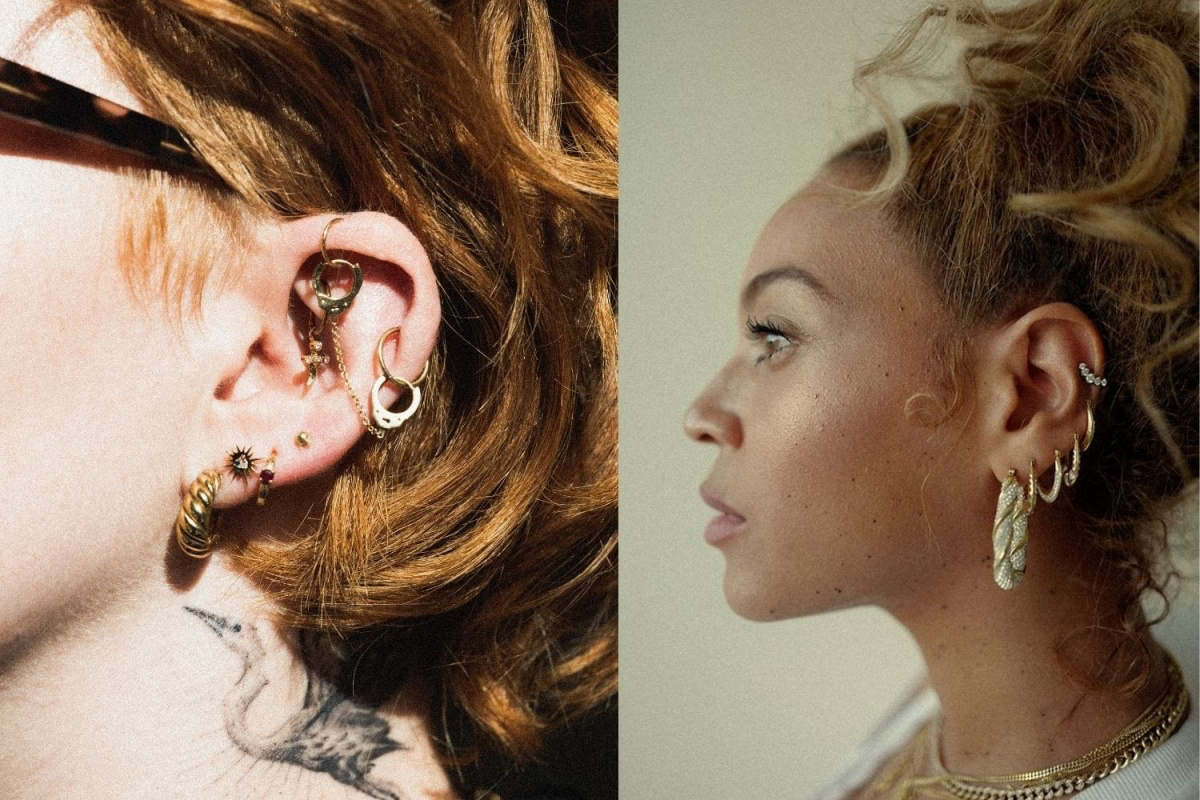
Types of Cartilage Piercings
Cartilage piercings present a captivating world of possibilities, allowing you to craft your style statement with precision and flair. Each type of cartilage piercing has its unique charm and offers a distinctive way to express your individuality. Let’s delve into the elegance of these various cartilage piercing types:
Helix Piercing
Description: The helix piercing, arguably the most popular cartilage piercing, adorns the outer rim of your ear. It offers a range of options, from a single stud to an artful constellation of jewelry along the rim. You can opt for a forward helix (near the front of the ear) or a classic helix (mid-outer rim) piercing. Its versatility makes it a fantastic choice for those looking to make a stylish yet understated statement.
Why It’s Loved: The helix piercing’s adaptability allows for endless creativity when choosing jewelry, making it a favorite among fashion-forward individuals. Its position on the ear offers a stunning canvas for showcasing unique studs, hoops, and ear cuffs.
The helix is the most popular cartilage piercing

Tragus Piercing
Description: Located on the small, raised flap of cartilage just above the earlobe, the tragus piercing is a subtle yet stylish choice. It offers a minimalist look while still adding an element of individuality. Due to its small size and unique placement, it’s often adorned with delicate studs, tiny hoops, or dainty barbells.
Why It’s Loved: The tragus piercing’s understated charm and minimal discomfort during the piercing process make it a popular choice for those seeking a subtle yet sophisticated accessory.
The tragus piercing is a subtle yet stylish choice
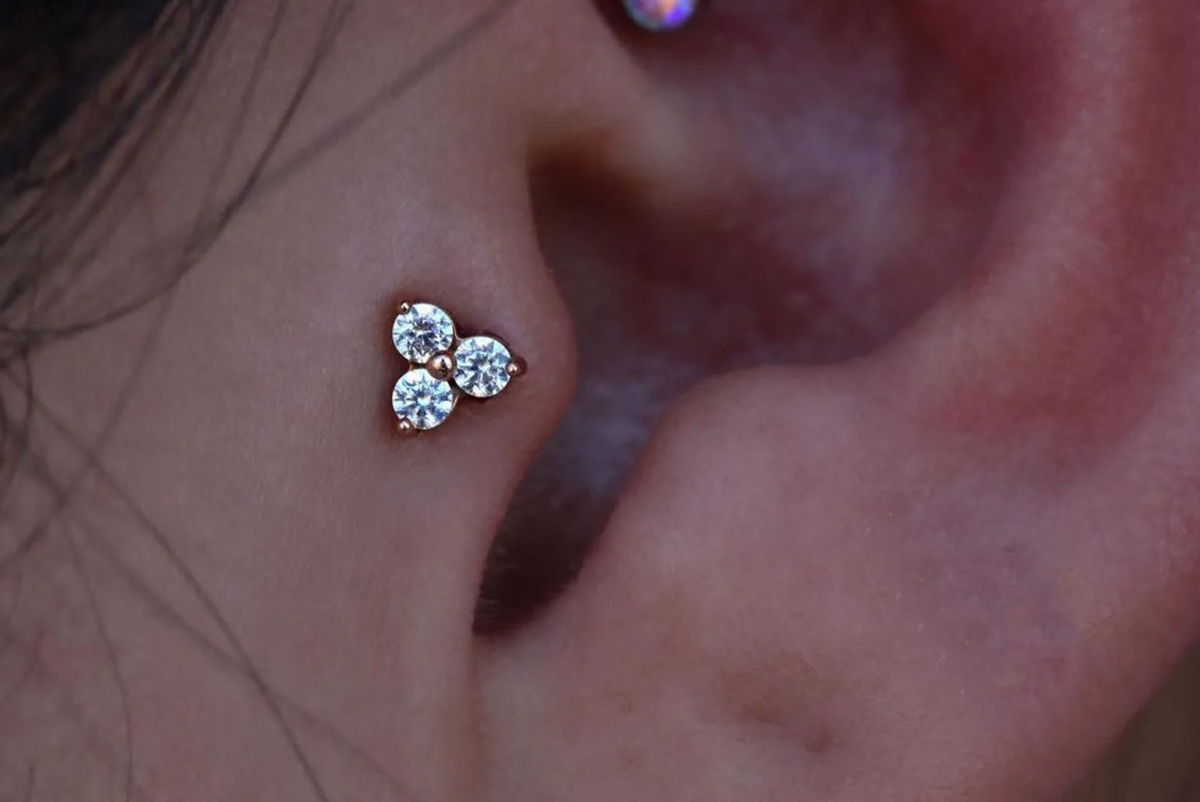
Conch Piercing
Description: The conch piercing is named after the conch shell’s spiral shape, and it can be located in either the inner or outer conch area of the ear. The inner conch piercing is placed in the central hollow of the ear, offering a unique and eye-catching focal point. On the other hand, the outer conch piercing decorates the flat cartilage above the earlobe. Both variations provide ample space for showcasing elegant jewelry.
Why It’s Loved: Conch piercings offer a blend of uniqueness and versatility. Whether you choose the inner or outer conch, this piercing type allows for diverse jewelry options, from studs and rings to captivating ear cuffs.
The inner conch piercing is placed in the central hollow of the ear
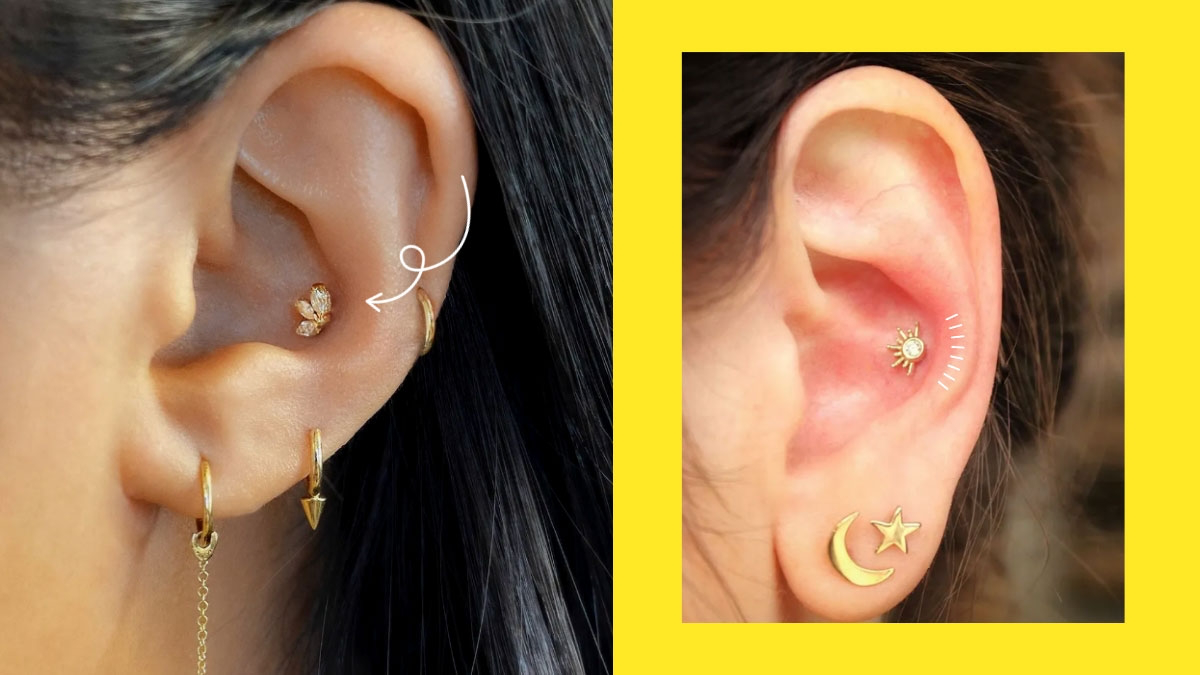
Daith Piercing
Description: Nestled within the innermost fold of cartilage above the ear canal, the daith piercing is like a hidden gem. Its concealed location allows you to maintain a professional appearance while indulging in the allure of body art. Daith piercings often feature small, intricate hoops that hug the ear’s curve.
Why It’s Loved: Daith piercings appeal to those who desire a discreet yet trendy addition. The inner ear placement offers a touch of mystique, making it a chic choice for both creative self-expression and professional settings.
The daith piercing is like a hidden gem

Rook Piercing
Description: The rook piercing is nestled in the fold of cartilage located just above the tragus and inner conch. Its unique positioning creates a visually captivating effect, with jewelry peeking out from the ear’s upper layers. The rook piercing often showcases curved barbells or curved rings.
Why It’s Loved: The rook piercing’s distinctive placement adds an element of intrigue to your ear jewelry collection. Its position between the inner conch and tragus provides a captivating contrast and an opportunity to explore various jewelry styles.
The unique positioning of the rook creates a visually captivating effect
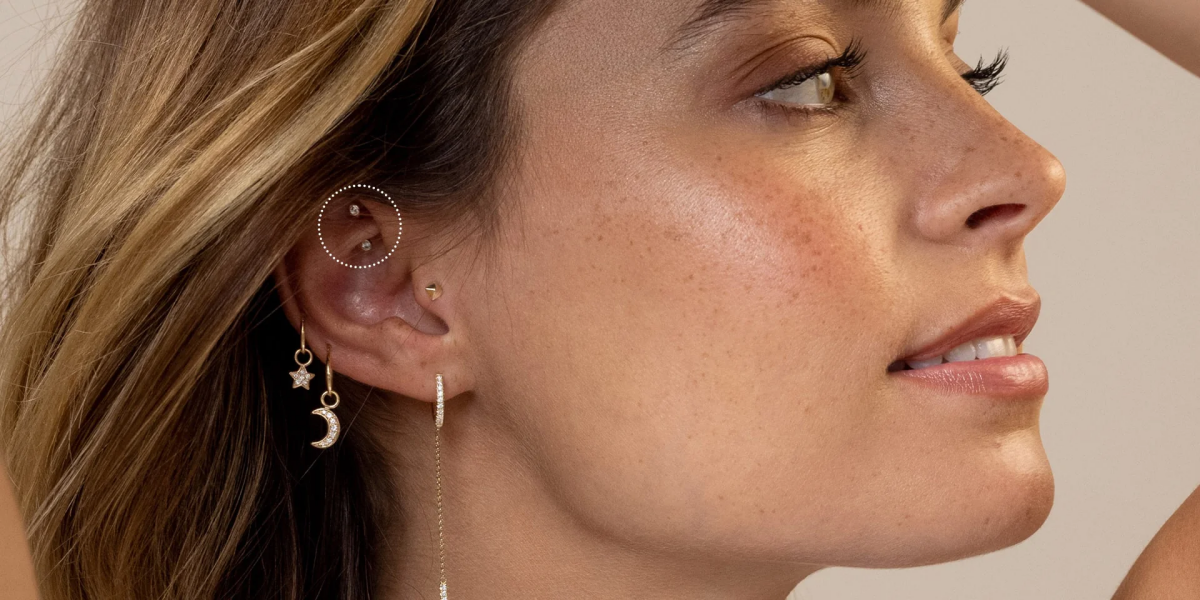
Snug Piercing
Description: The snug piercing traverses the cartilage along the ear’s inner rim, creating a stunning and distinctive look. Its placement follows the curve of the ear’s inner shell, making it an eye-catching addition to your ear jewelry ensemble. Snug piercings are typically adorned with snug-fitting, minimalist jewelry, such as small hoops or curved barbells.
Why It’s Loved: The snug piercing’s unique positioning along the ear’s curve offers a striking aesthetic. Its clean, minimalist jewelry options make it a versatile choice for those seeking a balance between subtlety and style.
The snug piercing follows the curve of the ear’s inner shell
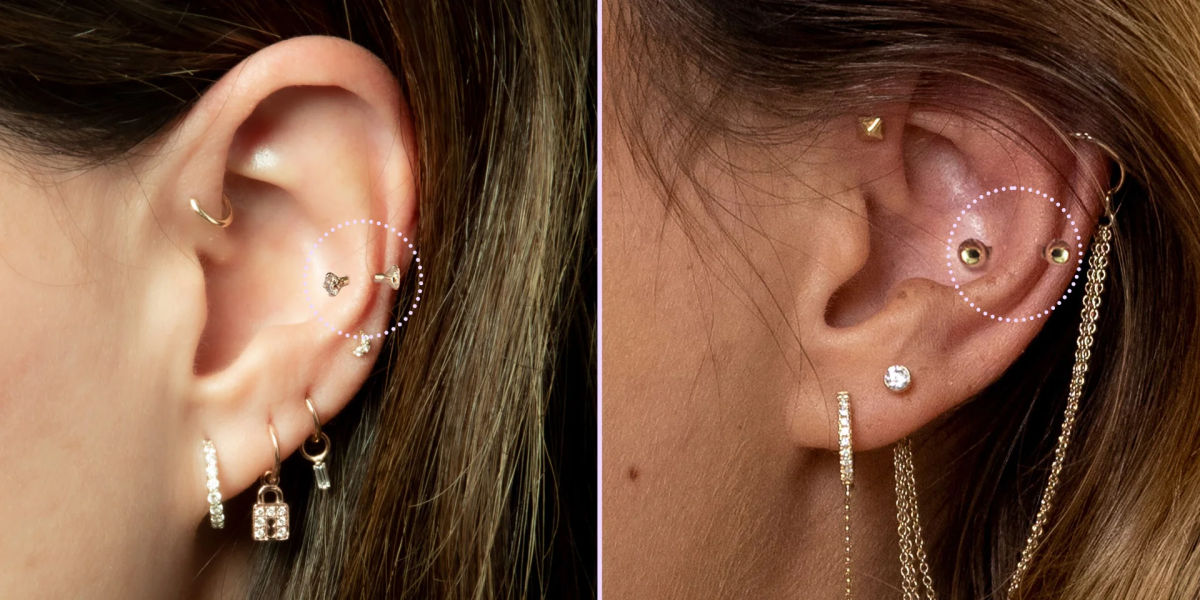
Industrial Piercing
Description: Industrial piercings are known for their bold and attention-grabbing appearance. They involve two piercings connected by a single piece of jewelry, often an industrial barbell. One end of the barbell is inserted through the helix, while the other end passes through the forward helix, creating an edgy, avant-garde look.
Why It’s Loved: The industrial piercing is a favorite among those who crave a striking, unconventional style. Its unique jewelry and bold design make a bold fashion statement that sets you apart.
The industrial piercing is known for its attention-grabbing appearance
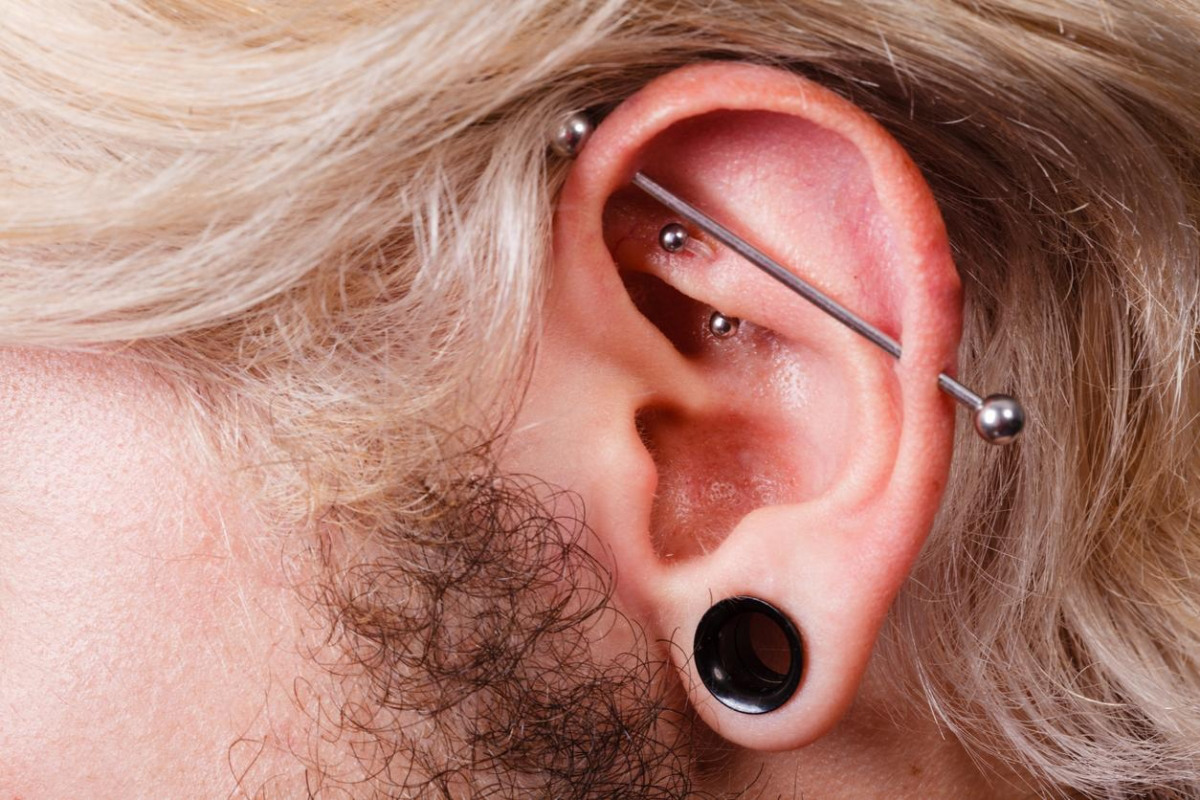
Orbital Piercing
Description: Orbital piercings feature two closely spaced piercings connected by a single hoop or ring, creating a captivating loop effect. The jewelry follows the curve of the ear, typically passing through the helix and anti-helix or other suitable locations.
Why It’s Loved: Orbital piercings are favored for their innovative and artistic design. They offer a visually intriguing composition while allowing for various jewelry styles to elevate your ear’s aesthetics.
Orbital piercings create a captivating loop effect

Forward Helix Piercing
Description: Positioned along the upper ear’s front, the forward helix piercing exudes a contemporary and elegant vibe. It usually features small, delicate studs or hoops that adorn the ear’s most visible section.
Why It’s Loved: Forward helix piercings are appreciated for their stylish placement and the opportunity to showcase charming jewelry choices. They add a touch of sophistication to your overall look.
The forward helix piercing exudes a contemporary vibe

Flat Piercing
Description: Flat piercings are placed horizontally through the flat cartilage at the top of the ear. They offer a distinctive and fashion-forward look, often featuring unique studs or minimalist jewelry.
Why It’s Loved: Flat piercings are cherished for their modern and fashion-forward appearance. Their placement provides ample room for artistic expression and individual style.
Flat piercings offer a lot of creativity in the jewelry department

Earhead Piercing
Description: The earhead piercing is a regal and uncommon choice. It’s positioned on the ear’s uppermost curve, creating an enchanting and sophisticated look. This type of piercing typically accommodates small hoops or dainty studs.
Why It’s Loved: Earhead piercings exude an air of elegance and luxury. Their unique placement allows you to wear jewelry that complements both casual and formal attire.
The earhead piercing is definately an uncommon choice
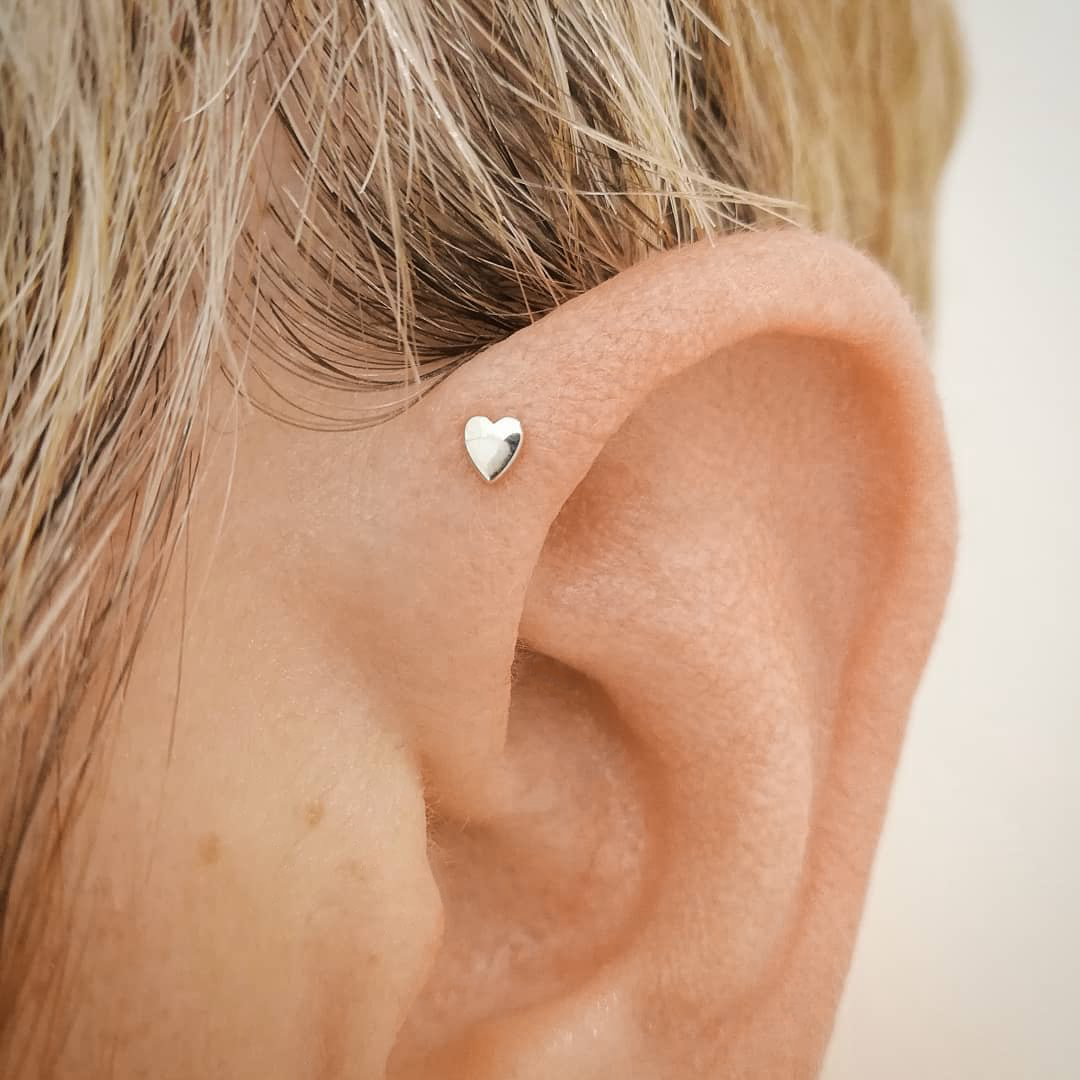
Helix Orbital Piercing
Description: Helix orbital piercings combine the beauty of the helix and orbital piercings, resulting in a mesmerizing and intricate composition. These piercings typically involve two helix piercings connected by a ring, allowing for a captivating jewelry arrangement.
Why It’s Loved: Helix orbital piercings are celebrated for their complex and eye-catching design. They offer an opportunity to showcase artistic jewelry arrangements and create a striking visual impact.
This piercing combines the styles of helix and orbital piercings

Triple Helix Piercing
Description: As the name suggests, the triple helix piercing consists of three separate helix piercings. These piercings are artfully spaced along the outer rim of the ear, creating a stunning visual cascade. Jewelry choices range from studs to hoops, allowing for creative combinations.
Why It’s Loved: Triple helix piercings are adored for their dynamic and visually appealing arrangement. They enable you to curate a captivating ear jewelry ensemble.
The triple helix piercing is a stunning visual cascade
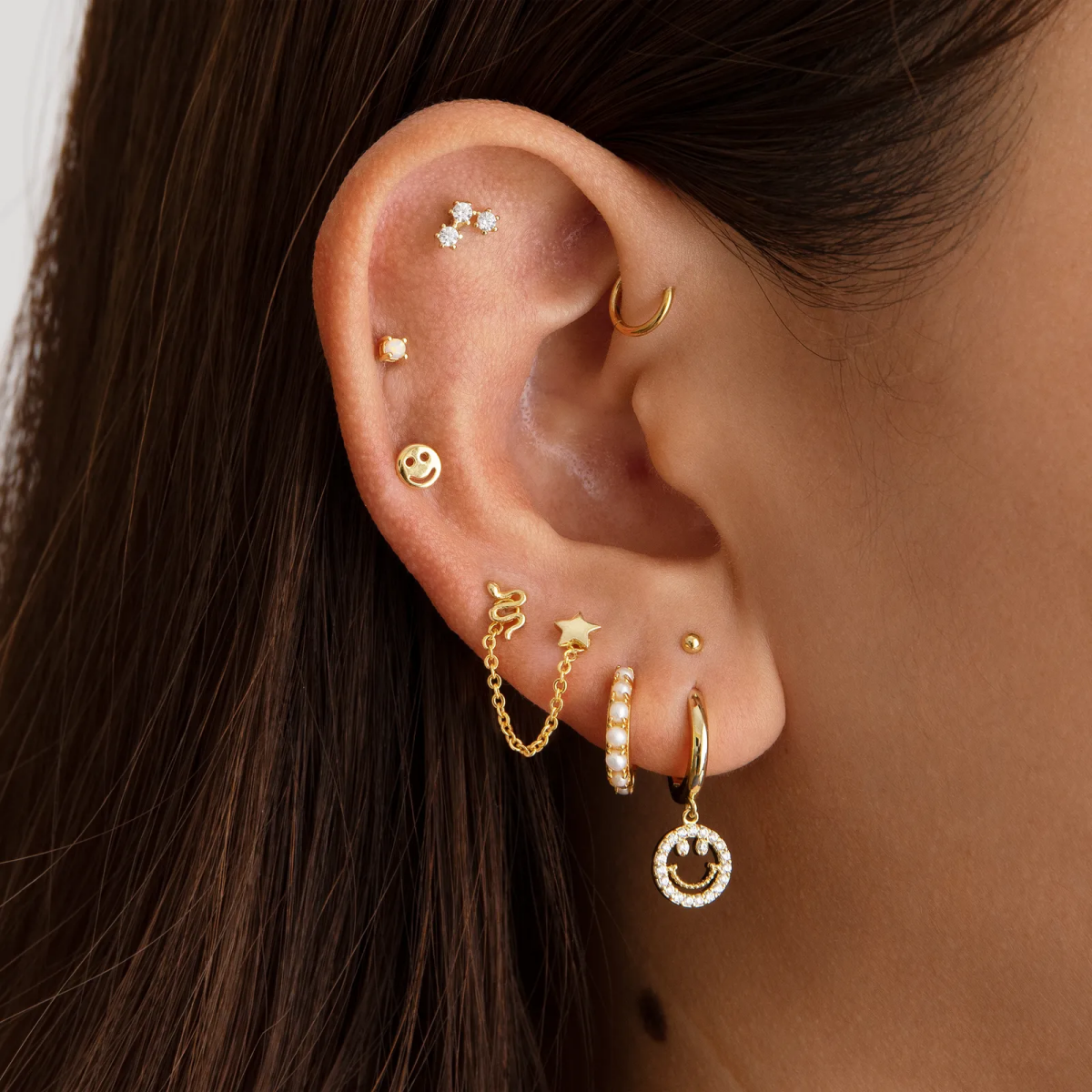
Quadruple Helix Piercing
Description: The quadruple helix piercing is an extravagant choice that involves four helix piercings along the outer rim of the ear. This symphony of piercings allows for intricate and ornate jewelry arrangements.
Why It’s Loved: Quadruple helix piercings are embraced by those seeking an extravagant and glamorous ear adornment. They provide a platform for showcasing elaborate jewelry creations.
The quadruple helix piercing is an extravagant choice

Antitragus Piercing
Description: The antitragus piercing is located just below the tragus, on the ear’s outer rim. It offers a unique and stylish addition to your ear jewelry collection. This piercing type is often adorned with small, elegant studs or hoops.
Why It’s Loved: Antitragus piercings are treasured for their distinctive placement and the opportunity to wear charming and sophisticated jewelry.
The antitragus is located on the ear’s outer rim
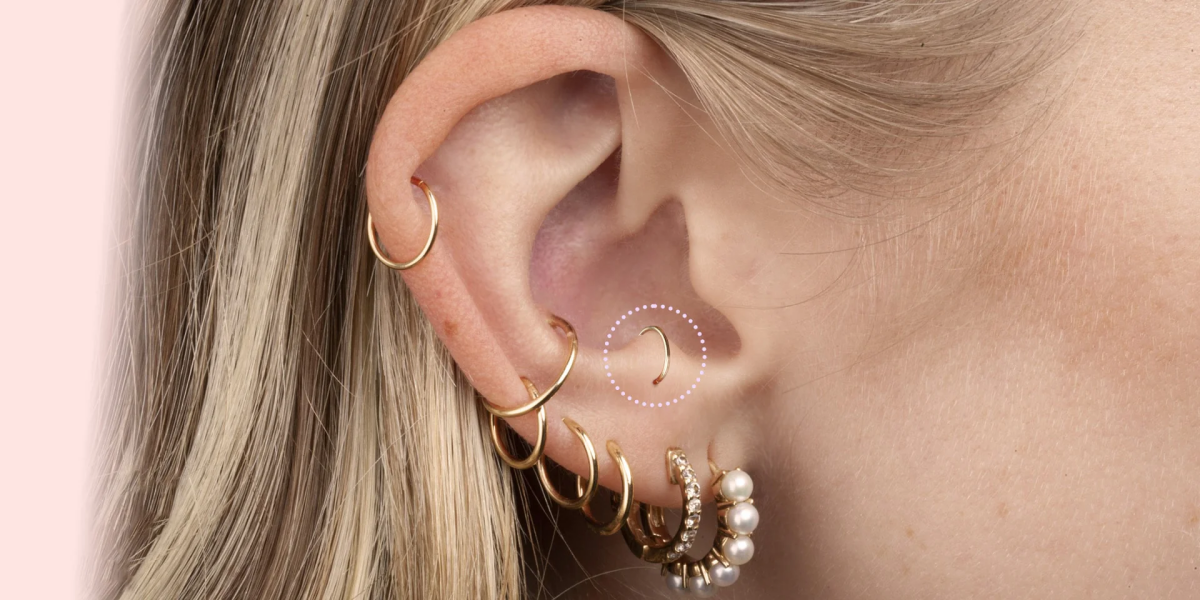
These are some of the most popular cartilage piercing types, each with its distinct allure and charm. Your choice of cartilage piercing allows you to express your style, enhance your look, and embrace the world of body art. Whether you opt for subtle elegance or bold extravagance, cartilage piercings offer endless possibilities for self-expression.
Advantages and Disadvantages of a Cartilage Piercing
Cartilage Piercing Pros
- Style Elevation: Cartilage piercings are the epitome of cool and can elevate your overall appearance, offering a unique and trendy look.
- Longevity: Due to the minimal movement in these areas, cartilage piercings generally heal more quickly and have fewer complications compared to piercings in more active areas.
- Earring Variety: One of the exciting advantages is the sheer variety of jewelry options available, ranging from elegant studs to chic hoops and intricate barbells designed specifically for cartilage piercings.
Cartilage Piercing Cons
- Sensitivity and Pain: It’s essential to prepare for the discomfort that often accompanies the initial piercing, as cartilage tissue is denser than lobe tissue.
- Infection Risk: As with any piercing, there’s a chance of infection if proper aftercare isn’t observed.
- Healing Time: Cartilage piercings require patience, as they typically take longer to heal compared to lobe piercings. It’s crucial to commit to the healing process.
These are the main pros and cons of a cartilage piercing
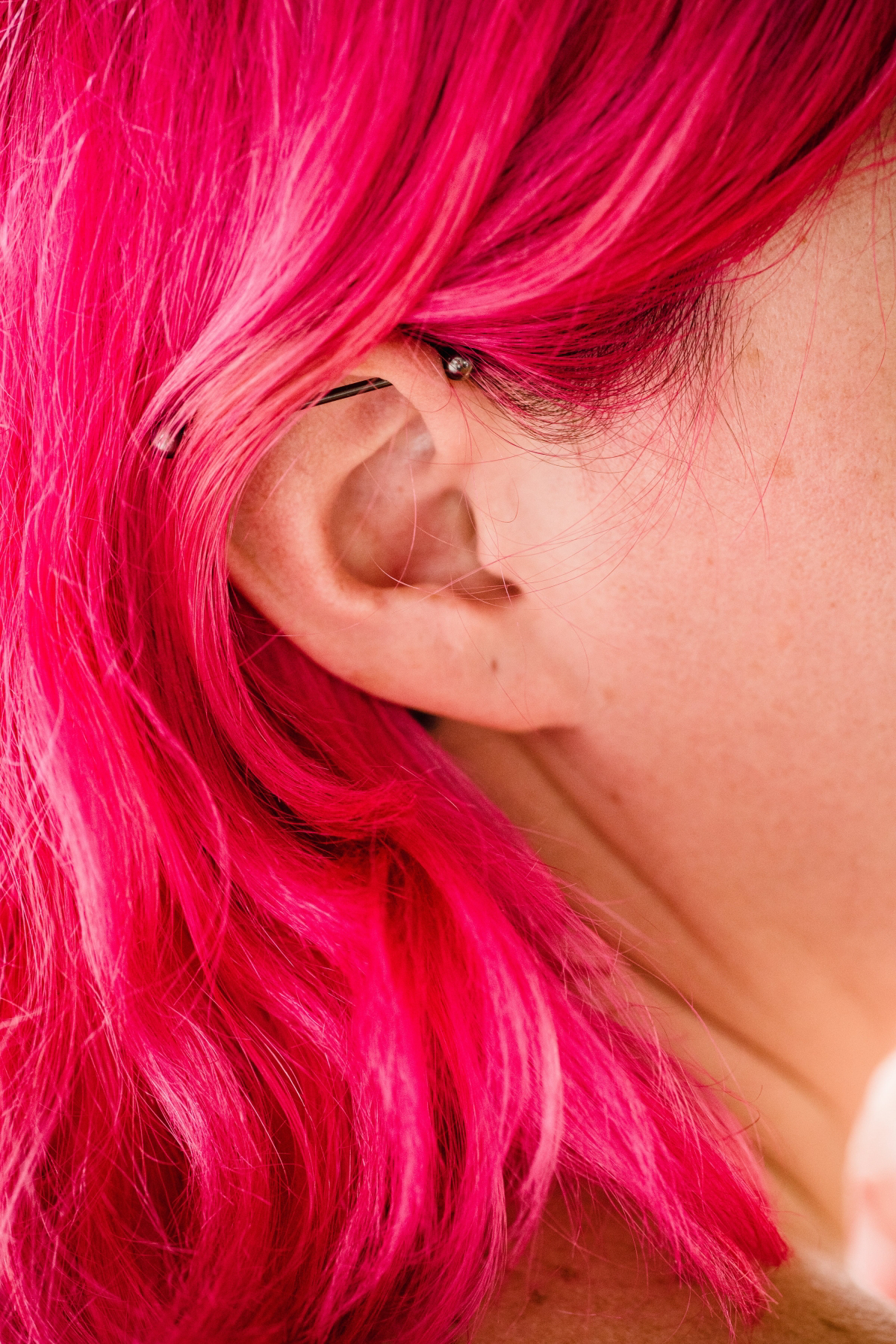
Who Should Get a Cartilage Piercing? Who Should Avoid It?
Cartilage Piercing Candidates
Cartilage piercings offer versatility, making them suitable for individuals seeking either a subtle accent or a bold fashion statement. These piercings are ideal for those who appreciate artistry and daring self-expression. Generally, anyone over the age of consent can get a cartilage piercing, provided they are willing to invest time and effort in proper aftercare.
Cartilage piercings are great for individuals seeking a bold fashion statement

Those Who Should Avoid Cartilage Piercings
While cartilage piercings can be incredibly stylish and alluring, some individuals may want to reconsider or exercise caution. Those who may want to avoid cartilage piercings include:
- Keloid-Prone Skin: Individuals with a tendency to develop keloids (raised, thickened scars) should be cautious, as cartilage piercings have a slightly higher risk of keloid formation.
- Active Lifestyle or Professions: People with highly active lifestyles or professions that require helmets, headphones, or other items that may irritate the piercing should think twice, as constant friction can hinder the healing process.
- Medical Conditions: Those with medical conditions that could impair the body’s natural healing processes should consult with a healthcare professional before getting a cartilage piercing.
Consider these situations before getting a cartilage piercing

Caring for Your Cartilage Piercing
Post-Piercing Care
Once you’ve taken the plunge and adorned yourself with a stylish cartilage piercing, the journey toward showcasing your new accessory has only just begun. Proper care and maintenance are paramount to ensure your piercing remains both stunning and healthy.
- Cleaning Routine: Establishing a consistent cleaning routine is crucial to prevent infection and maintain your piercing’s health. Utilize a saline solution or specialized piercing aftercare spray to gently clean your piercing twice a day.
- Hands Off: The temptation to touch or twist your piercing may be strong, but this can introduce bacteria and hinder the healing process. Resist the urge and refrain from unnecessary contact.
- Avoid Swimming: While swimming can be a delightful pastime, submerging your fresh cartilage piercing in pools, hot tubs, or unclean water should be avoided until it has fully healed.
A good post-piercing cleaning routine is key
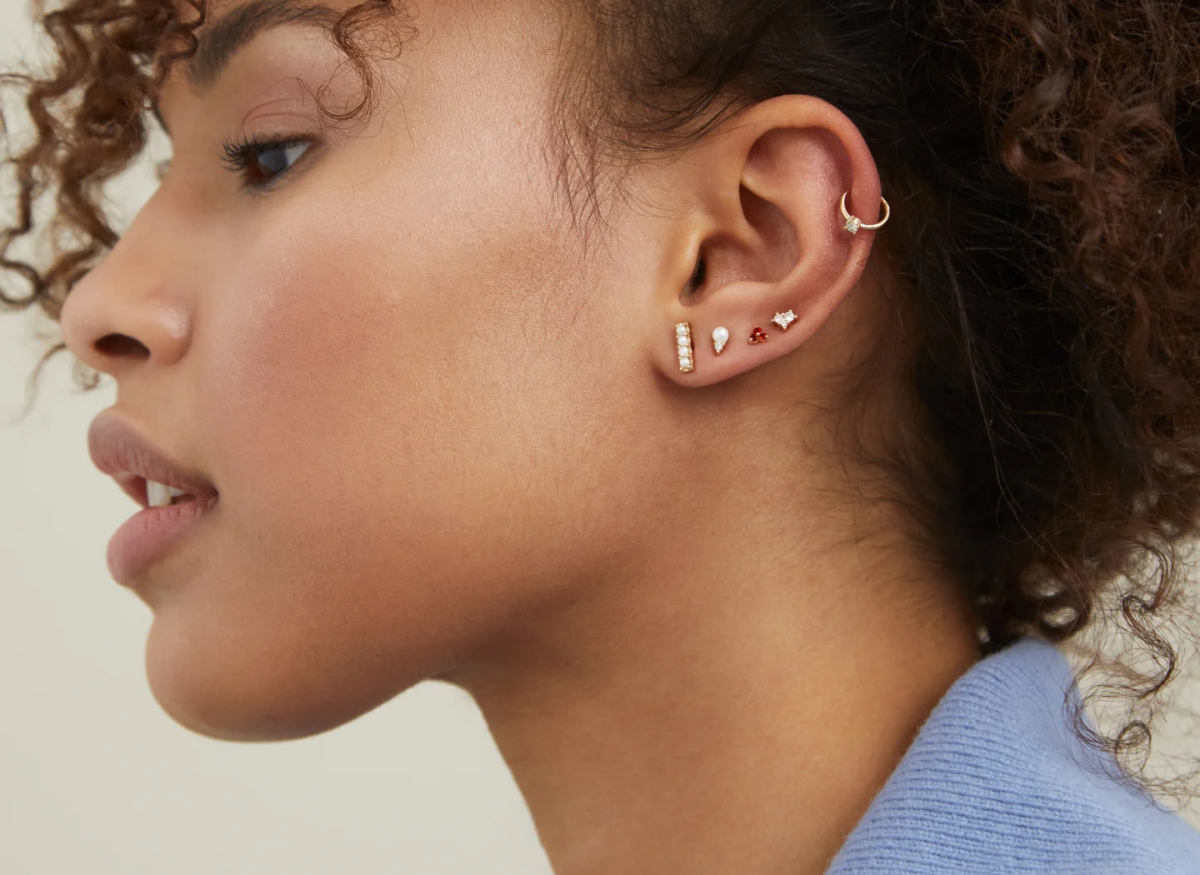
Tips and Tricks for Healing Your Cartilage Piercing
- Timeframe: Be prepared for the healing process, which can take anywhere from a few months to a year. It’s important to remember that healing times can vary from person to person.
- Sleeping Comfort: To ensure your comfort and promote healing, avoid sleeping directly on your cartilage piercing. Opt for a travel pillow or a specialized piercing pillow to alleviate pressure while you rest.
- Consult a Professional: If you experience unusual swelling, discharge, or signs of infection, don’t hesitate to reach out to a professional piercer or a healthcare provider for expert guidance and assistance.
Be prepared for the long and uncomfortable healing process

Conclusion
Cartilage piercings have become synonymous with style, individuality, and self-expression. These chic and elegant additions offer a unique canvas for showcasing your personality and fashion sense. Whether you’re a trendsetter, a minimalist, or someone exploring new avenues of self-expression, cartilage piercings are your ally in the journey to a more stylish and self-assured you. With proper care and commitment to the healing process, you can confidently embrace this style statement, knowing that it’s an adventure well worth taking.
Now you know everything about cartilage piercings!

